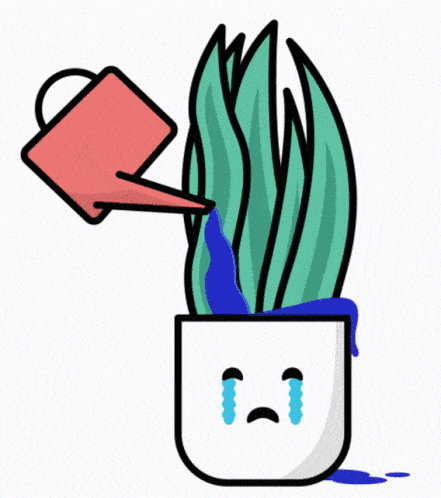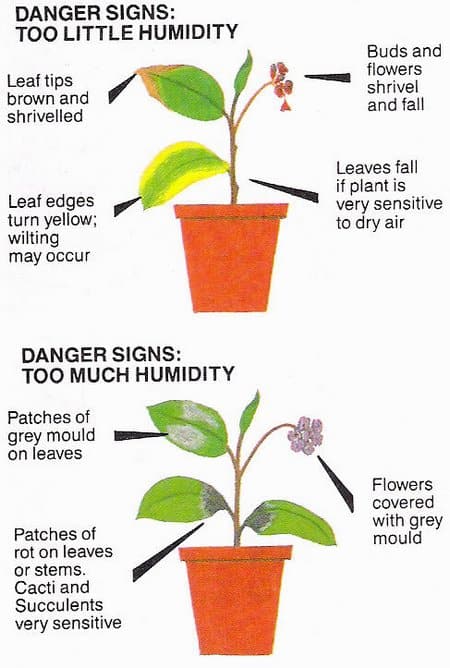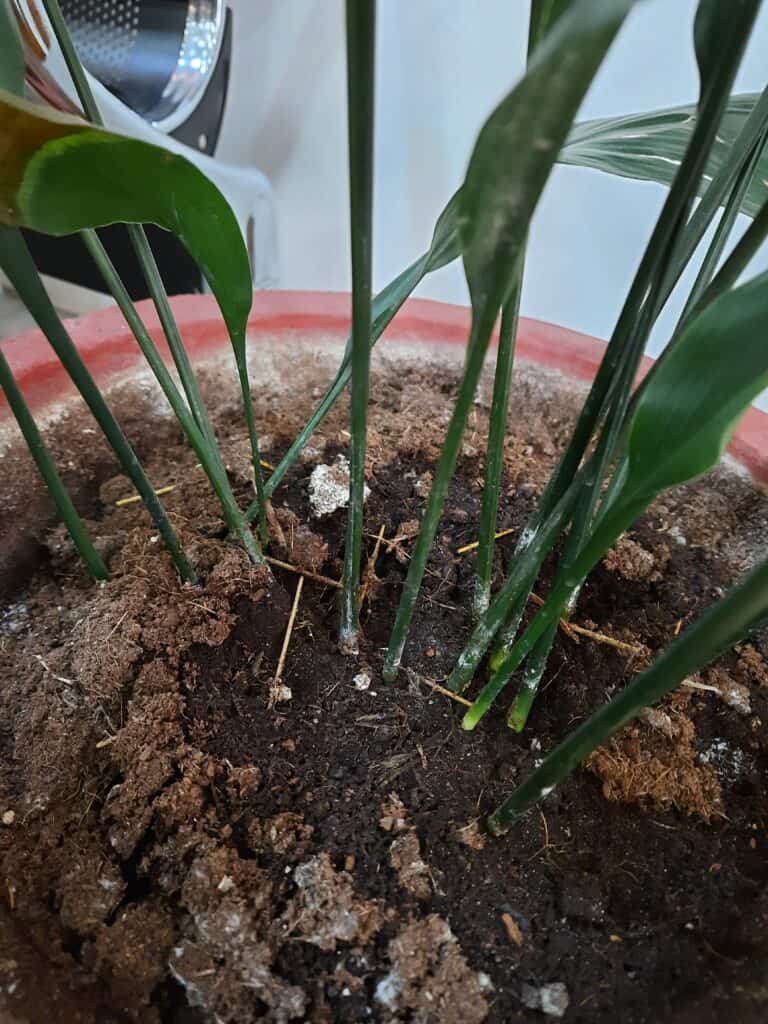Long, lustrous, leathery leaves of Chinese Evergreen may start curling under improper care regime.

Did you encounter this problem? Fret not! We are here to help you out.
Read our article further to know the solution to Chinese Evergreen leaves curling.
Table of Contents Show
Is it Normal for Chinese Evergreen Leaves to Curl?
Chinese Evergreen has specific condition requirements for proper functioning.
If those conditions are not met, they are bound to show their stress by turning yellow, brown, or curling their leaves.
You should not be too worried about the curling unless you are too late in identifying the problem. The key is to diagnose the cause as soon as possible.

All curling should not be taken seriously, though.
Sometimes this plant may curl its leaves because of the following factors and can be reverted to normal in no time.
- Aging
- Transplant Shock
- New Leaves
Causes of Chinese Evergreen Leaves Curling [With Solutions]
Chinese Evergreen leaves may curl because they are not satisfied with the care you’re providing.
In most cases, if you resume excellent care for them, they will be back healthy. Let’s look at the causes and read about them in detail.
1. Overwatering the Plant
Chinese Evergreen plants thrive in soil with plenty of moisture, but people add excess water to it.
Excess moisture in the pot causes damage to the root of the plant. The plant cannot absorb water and minerals to support its healthy growth.
Too much water can cause root rot and curled leaves.
Curling of leaves is the initial sign of overwatering. It brings other problems like yellowing and loss of leaves.

Chinese Evergreens prefer dry soil rather than an overly moist mix. They need a well-draining medium that stays slightly damp as the roots drown in too-wet soil.
Also, you should be worried about root rot. Standing on water too long can invite root rot in the plant.
Save an Overwatered Chinese Evergreen
- Unpot the plant and inspect for rot if you suspect overwatering.
- Place the plant in a sunny place and let the roots dry naturally.
- Trim-infected areas and cut roots are black, mushy, and foul-smelling; healthy roots are pale and firm with an earthy odour.
- Repot the plant with fresh (dry) soil. The soil will dry faster if there is good air movement.
Tips to Water Chinese Evergreen Properly
- Let the top two inches of the soil dry out before watering the plant again. You can do the finger soil test to determine if the soil has dried out.
- Water the plant every 8-9 days during its growing phase, i.e., summer and every two weeks during winter. Respect its dormancy.
- If you have kept your plant in an area with less light, you should water the plant less.
2. Underwatering the Plant
Chinese Evergreen leaves curling due to Underwatering can be a real headache. Although underwatering may not pose as much threat as overwatering, it is still a problem.
If you do not provide enough water to your Chinese Evergreen, it may curl up its leaves to preserve whatever water is left on it.

Underwatering invites other problems like yellow leaves, brown tips, edges, droopy leaves, etc.
Due to underwatering, the bottom and older leaves fall off as the plant focuses only on the new growth and disseminates the remaining nutrients to them.
According to kids.frontiersin.org, Plants have “armor” that helps them to preserve and lose less water to the environment conditions.
In the case of Chinese Evergreen, the phenomenon of “armor” is the curling of leaves which prevents the loss of excess moisture to the environment.
If you ever encounter your plant curling leaves due to underwatering, quickly soak the pot in a basin or container and let it stay for a few minutes.
After the water has soaked into the plant, water it well until the excess water runs out of the drainage holes.
Wanna know more in detail? Read our article “How Often to Water Chinese Evergreen?”
3. Direct Sunlight
Chinese Evergreen plant is a hardy, tropical and subtropical plant. They belong to the genus Aglaonema, famous for surviving even in low light conditions.
That doesn’t mean you push your plant to spend its life in darkness. Or, its life won’t be a long one.
The primary light condition that poses a severe threat to the plant’s appearance is direct bright sunlight.
Direct light can scorch and burn the leaf tips and eventually lead to the curling of the leaves.

The leaf curl occurs due to a chemical reaction caused by too much light. Too much light equals too much photosynthesis. Chill! Your plant has to breathe.
American Society for Horticultural Science says, leaf size decreases, and the leaves are lost in low light.
Chinese Evergreen needs at least 10 hours of medium-intensity light. Or low light conditions can work well for this plant as well.
But make sure to avoid direct sunlight at any cost. If the light conditions are not that good, you can go for artificial grow lights. Or move your plant to a brighter spot.
You can put the plant to few feet away from the window, and even if you place the plant near the window, use curtains and drapes to prevent direct sunlight.
4. Low Humidity
Chinese Evergreen belongs to the subtropical and tropical regions of Asia and New Guinea.
As you must know, tropical plants prefer more humidity. So if your plant is in an area with less humidity, you may witness curled leaves.
In low humidity conditions, plants tend to lose moisture quickly. So to conserve what is left of the moisture, Chinese Evergreens curl up their leaves.

The perfect humidity range for Chinese Evergreens is 60%-70%.
Tips to Maintain Ideal Humidity
- Mist the leaves more often to maintain the required humidity.
- Invest in a humidifier and place it in a room with the plant.
- Put a pebble tray near or below the plant to keep the humidity in check.
- Place the plant in high humid zones like the Kitchen or Bathroom.
- Group your Chinese Evergreen with other plants. Due to the transpiration of these plants, the humidity levels will rise.
Note: Pests and diseases thrive in high-humidity environments, so keep an eye out for uncommon signs on a frequent basis.
5. Overfertilizing the Plant
Chinese Evergreens do not need much fertilizer for optimum growth as they are not heavy feeders.
Usually, when you overfeed your plants, the residues accumulate in the salt. This process toxifies the soil, and the roots cannot take up the required nutrients.
If the leaves do not get enough nutrients, leaves start to curl.

Other symptoms of overfertilizing include yellow leaves, stunted growth, brown spots on leaves, etc.
Fertilizer can induce growth in the plant and make the plant more luscious and healthy, but overdoing it can affect its vulnerable stem, leaves, root, etc.
Chinese Evergreen flourishes in a well-balanced NPK ratio of 10-10-10 if you feed them at least once a year in spring and summer.
You can also go for fish emulsion or any slow-release fertilizer during Chinese Evergreen’s growing seasons.
Picking the right fertilizer is essential, or you might overfertilize the plant.
You may use compost, but remember, the compost may not contain all the nutrients the plant needs, so avoid using compost only.

Fix Overfertilization Issue
- Inspect the affected parts. Prune the part away if they are beyond fixing. You can restore curled leaves.
- Identify the salt build-up on the soil and scrape off the excess build-up.
- Or, you can wash the build-up with a water hose.
- If fertilizer has degraded the soil quality, it will be best to repot the plant in a fresh potting mix.
- Before repotting, make sure to prune the dead parts off the plant.
- Avoid fertilizing during the cold months of winter.
- Dilute the fertilizer with water to half-strength before fertilizing the plant.
6. Pest Infestation
Chinese Evergreen is a beautiful-looking plant that is poisonous to pets and humans. Pests are a different case, though!
Although this plant is not free from the attack of those sturdy little pests, they don’t prove life-threatening to the plant.
Pests like mealybugs, spider mites, aphids, and scales hamper the plant’s ability to grow optimally.

These bugs suck out water and nutrients from the plant before it reaches the leaves, and hence the plant’s leaves curl.
There could be a pest infestation if your plant shows the following symptoms.
- Leaves falling off in unusually stunted growth and loss of colors in leaves denote mealybugs infestation.
- Webs on leaves and stems discolored spots on the leaves denote spider mites.
- The presence of honeydew distortion in leaves shows aphid infestation.
- Branch dieback honeydew denotes scale infestation.

Treatment for Pest Infestation
- Wash off the infected part of the plant with a strong force of water in case of a small infestation.
- You can bring Neoseiulus californicus, a predatory mite, to control the population of spider mites.
- Spraying your plant with horticultural neem oil or insecticidal soap can help you get rid of a few pests.
- Dust off the leaves and keep them clean to avoid the infestation altogether.
- You can use 70% isopropyl alcohol to get rid of scales and mealybugs. Use a cotton ball to apply the alcohol to the plant foliage.
You can make your Mealybug fertilizer. To make a paste, combine a small onion, a garlic bulb, and a teaspoon of cayenne pepper. Soak it for an hour in 2 quarts of water.
Using a strainer, strain off the liquid and add a spoonful of dish soap. Before spraying the plant, let the solution sit for a week.
Watch the video to get rid of pests organically,
7. Nutrient Deficit
Although the Chinese Evergreen is not a heavy feeder, the curling leaves could be due to a lack of nutrition.
A lack of fertilization or repotting causes nutrient deficit. Over time, the soil loses all of its nutrients and cannot absorb fertilizer nutrients.
Nitrogen deficiency may also cause the leaves to curl. It usually affects the oldest (lowest) leaves first because the plant transfers the nitrogen from the existing leaves when new leaves don’t obtain enough to continue their growth.
Other symptoms of nitrogen deficit include lower leaves turning yellow and mushy, leaves curling inwards, and brown and crispy leaves.
At times, the pH level of the soil can be an issue. A slightly acidic soil enhances nutrient absorption in your Chinese Evergreen; an alkaline combination might limit nutrient utilization.

Solutions
- If the soil’s pH level is unsuitable for the plant, add some compost.
- Fertilize your Chinese Evergreen with diluted fertilizer during the growing season.
- If you haven’t repotted the Chinese Evergreen in a long time, you’ll need to do so using a new potting mix.
- Provide your plants with amino-acid supplements. Amino acids enable your plant to generate protein, which aids in the uptake and utilization of nitrogen.
- Give a high-nitrogen nutrition formula to plants in their vegetative growth stage.
- Fertilizers made from decomposing fish tankage (processing waste) give a high dose of nitrogen in a form that plants can readily absorb and use.
- Test soil pH regularly. Chinese Evergreen prefers lightly acidic soil, i.e., pH around 5.6 to 6.5.
Watch this video to learn more about the importance of soil pH,
8. Poor Water Quality
Chinese Evergreen is not so picky about the water it needs but may sometimes reject the quality of water it gets.
The curling of leaves due to poor water quality is a concept that is rarely heard of. But you cannot rule out that possibility altogether.

What kind of water you use for your plant has a significant impact. Using tap water may contain various harmful chemicals and minerals that may cause your plant’s leaves to curl.
High soluble salt levels in tap water can affect roots by disrupting water and nutrient absorption. Salts can build up in plant leaf margins, causing the edges to curl and burn.
Solutions
- You can eliminate the chlorine from the water by boiling it for a few minutes.
- Use rainwater, spring water, or filtered water.
- If you still want to use tap water, fill a bucket with tap water and let it overnight to allow the minerals to evaporate.
Ever wondered if Chinese Evergreen is toxic to cats? Read more to find out.

From Editorial Team
Chinese Evergreen is not much hard to take care of. They tend to suit themselves in almost every environment.
Try to maintain good growing conditions to ensure healthy plant development and health. A magnificent Chinese Evergreen plant will provide you with many years of enjoyment.
Good luck with your Aglaonema!
